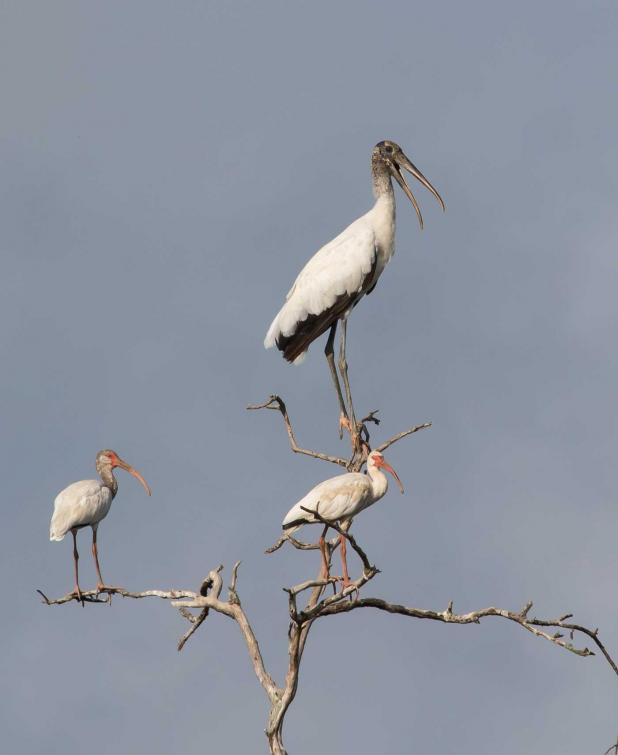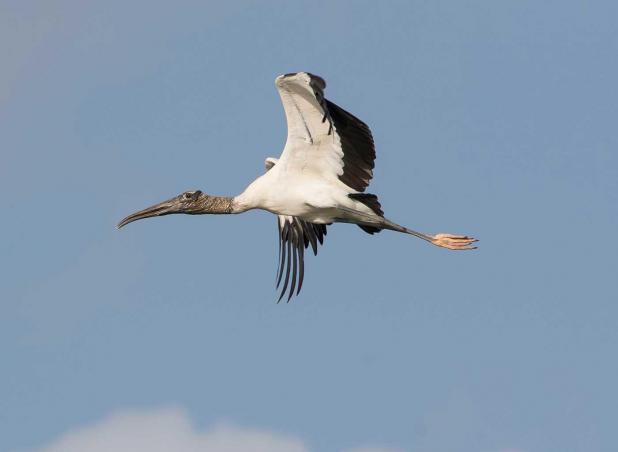
Wood Storks roosting during the mid-morning hours after feeding in crawfish farms around southwest Louisiana.
The Daily Review/John Flores

A wood stork takes wing in the summer sky.
John Flores: Summer is a great time to watch La. wood storks
Some of your first thoughts when storks come to mind may be the commercialized caricature of a large white bird carrying a human baby in a bundle to expecting parents.
Some of that folklore perhaps comes from Hans Christian Anderson’s 1838 fairytale classic “The Storks.” Noteworthy of Anderson’s enchanting fable is it actually reflects intercontinental migration of the storks providing intriguing realism to the story.
LiveScience.com contributor Emma Bryce, in her 2018 article, “What’s Behind the Myth That Storks Deliver Babies?” writes, “Whatever the origins of the myth, historians tend to agree that the idea of the baby-bringing stork was most firmly established in northern Europe, particularly Germany and Norway.”
In her essay Bryce goes on to say, “During the Pagan era, which can be traced back at least to medieval times more than 600 years ago, it was common for couples to wed during the annual summer solstice, because summer was associated with fertility. At the same time, storks would commence their annual migration, flying all the way from Europe to Africa. The birds would then return the following spring, exactly nine months later.”
Unlike Anderson’s European White Stork, here in Louisiana we have migrating Wood Storks.
Retired Director of the University of Louisiana – Lafayette Crawfish Research Center, Jay Huner, says Wood Storks breed in the winter and then undergo post-breeding dispersal, where the bulk of the birds in Louisiana migrate from Mexico’s Yucatan.
Huner said, “Around 2000, the late Dr. Clint Jeske had a collaborative grant wherein transmitters were placed on Wood Storks caught in Louisiana. I think he had 10 wired storks. I seem to recall that eight went to Mexico and two went to Georgia-Florida. So, it is clear that birds from the east coast do move westward.
“Currently, the storks spend a lot of time in crawfish ponds,” Huner continued. “Draining starts as early as April and extends into September depending on all manners of conditions and management strategies. The egrets, herons, night-herons, ibises, spoonbills, and storks benefit immensely. In fact, Louisiana is one of the few places where wading bird populations have been expanding dramatically through time.”
A perusal of George H. Lowery Jr.’s book, “Louisiana Birds – Third Edition,” considered by many as the best resource and reference guide for individual species, reveals Wood Storks are most abundant in the state from around the second week in June through the end of September.
By late July, the vast majority of the heron and spoonbill species of birds have fledged their young. What nature lovers and birders are bound to see when seeking out Wood Storks in southwest Louisiana crawfish ponds, shallow flats and bayous in areas like the Henderson swamp in the Atchafalaya Basin, and agricultural region surrounding Sherburne Wildlife Management Area, is mixed populations of wading birds.
The sight can be an amazing experience as these wading birds forage and feed on an array of small creatures such as fish, crawfish, frogs, snakes and even reptiles.
Wood Storks scour water depths of 4 to 12 inches with their bills as they walk slowly. Their bills snap shut with the slightest sensation of prey. They also shuffle their feet along the bottom often times to scare-up food.
Even the most casual nature viewer can observe these characteristics while watching how they compare to the other species of wading birds.
This past weekend I observed a Yellow-crowned Night Heron slowly stalk a crawfish in clear water along a wide drainage ditch on Sherburne WMA. Nearby were White Ibises, Green Herons and Great Blue Herons.
In spite of all the competition, the Night Heron was successful and skulked into the edge of the woods to consume his meal without harassment from the others. It is sights like these that keep me going back for more.
Standing approximately 33 to 44 inches tall, with a wing span of 55 to 71 inches, Wood Storks are not the prettiest bird in the world. It is a beautiful snowy-white feathered bird with black primary, secondary, and tail feathers. However, the adult bird’s head and neck have no feathers and is predominately a darkish grey and considered to resemble a gourd.
The Wood Stork sports a thick downward-curved bill, which only makes this bird more unusual looking compared to other wading birds and truly an oddity in some regards.
Wood Storks will be around throughout the summer, our hottest time of the year. But, the nice part about looking for and watching them is you can do it from the confines of your air conditioned car or truck. Simply traverse some of the back roads of southwest Louisiana searching specifically for crawfish ponds east to west from Lake Arthur to Bell City and north to Iowa, Welch and Jennings. The birds tend to move around when foraging.
You’ll also want to get started just before sunrise. Quite often the storks have returned to their roost by 7 a.m., seemingly to avoid the intense summer heat of the Gulf Coast.
For those wanting to view White Storks by boat, the Henderson Swamp between Lafayette and Butte La Rose is a great place to start, along with the Whiskey Bay and the Lake Pelba areas of the Atchafalaya Basin.
If you’re not a “do it yourselfer” and unfamiliar with the swamp, there are tour guides in the area. Contact the Atchafalaya National Heritage Area Welcome Center for more information at 225-228-1094.
Regardless of whether or not you’re the adventurous type, summer is a great time to view Wood Storks and other wading birds in their natural habitats around the state.
